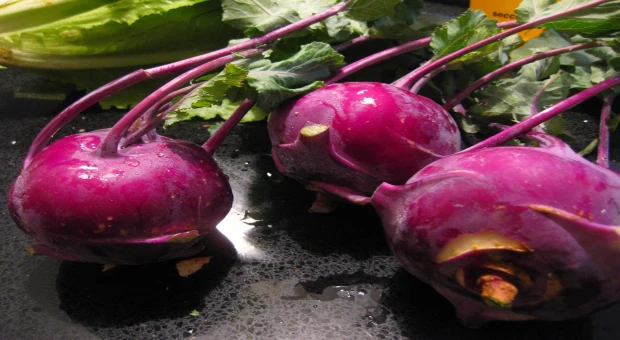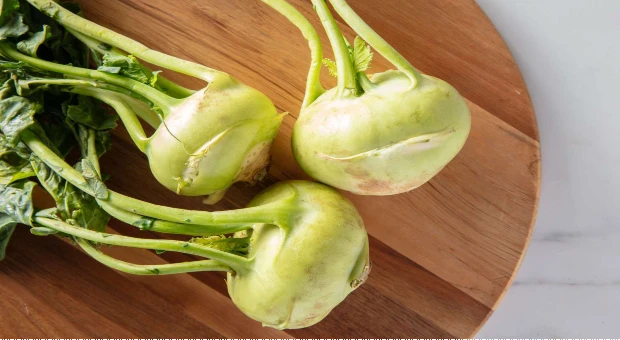Kohlrabi benefits, how to eat, harvest time, storage method
Kohlrabi Nutrition

| Kohlrabi (100g) Nutrition | |||
| Carbohydrate | Protein | Fat | Calories |
| 6.2g | 1.7g | 0.1g | 27kcal |
| Main Nutrition | Anthocyanins, Vitamin C | ||
| Main Benefits | Anti-cancer effect, skin health promotion, diet effect | ||
| Side Effects | Excessive intake may cause abdominal pain; patients with low thyroid function should not consume it. | ||
Kohlrabi is a vegetable belonging to the Brassica family. Its origin is Northern Europe, but the name kohlrabi was created in Germany. The current name kohlrabi was born by combining the German words kohl, which means cabbage, and rabi, which means cabbage. Kohlrabi comes in a variety of colors, including green and purple, but only the outer skin varies in color and the inside is all light yellow. Kohlrabi can be cooked in a variety of ways, including eating it raw or roasting it.
Kohlrabi Benefits

1. Anticancer effect
Kohlrabi contains an ingredient called glucosinolate. These ingredients are produced when kohlrabi is chewed or digested. In this ingredient, a component called sulforaphane is broken down, which inhibits the growth of cancer cells and promotes the death of cancer cells, which has an anti-cancer effect. It is also effective in preventing cancer because it helps prevent cell mutations that cause cancer.
2. Skin Health
Kohlrabi is rich in vitamin C. Vitamin C promotes collagen synthesis, which is essential for skin health, and helps inhibit melanin production, which darkens the skin. So it helps create healthy and elastic skin. Additionally, kohlrabi contains carotenoids, an ingredient that removes free radicals from the body, helping prevent skin aging.
3. Weight management
Kohlrabi is made up of about 90% water and is also low in calories. It is also rich in fiber, so it gives you a feeling of fullness even if you eat just a little, preventing overeating. It also helps prevent constipation by stimulating bowel movement. It also contains potassium, which helps eliminate sodium from the body and helps relieve swelling.
4. Vascular Health
Kohlrabi contains an ingredient called anthocyanin. This ingredient lowers bad cholesterol levels and acts as an antioxidant, helping maintain blood vessel health. It is also effective in preventing cardiovascular disease. Additionally, kohlrabi contains potassium, which has the function of dilating blood vessels, thereby relieving tension in blood vessels and arteries, preventing cardiovascular disease and improving blood vessel health.
5. Relief of constipation
Rich dietary fiber can soften stools and ease constipation by making bowel movements smoother.
6. Improves vision health
Additionally, the rich anthocyanin content is very good for eye health. Anthocyanin is rich in many purple vegetables and fruits such as aronia and blueberries. Consuming this nutrient prevents eye diseases such as glaucoma and cataracts and is very good for vision health.
Harvest time
Kohlrabi can generally be harvested 50 days after planting seedlings. The season is June, July, October, and November, and the ones harvested at these times are the most delicious.
Storage Method
Kohlrabi has a lot of moisture, so it is best to keep it refrigerated. After removing the stems and leaves, wrap them in plastic wrap or newspaper and refrigerate them to maintain freshness.
Side Effect
- If you are allergic to cabbage and vegetables, you should be careful as an allergic reaction may occur when consuming them.
- Kohlrabi contains a component called coitrogen, which causes a decrease in thyroid function, so people with thyroid dysfunction should be careful.
- Kohlrabi is rich in dietary fiber. So, you need to be careful because if you consume too much, you may feel abdominal bloating.
References
💠PharmEasy: Kohlrabi: Uses, Benefits and Side effects
💠HealthifyMe: The Surprising Health Benefits of Kohlrabi